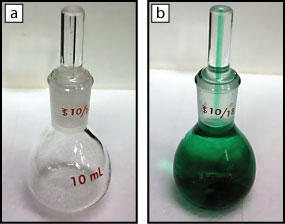Pycnometer SOP
Primary Equipment:
Pycnometer
Created: February 24, 2008 by Bob Cox
Revised: February 24, 2010 by Bob Cox
University of Utah, Chemical Engineering
The pycnometer (from the Greek puknos, meaning “density”, also called pyknometer or specific gravity bottle), is a flask with a close-fitting ground glass stopper with a fine hole through it, so that a given volume can be accurately obtained (Figure 1). This enables the density of a fluid to be measured accurately, by reference to an appropriate working fluid such as water or mercury, using an analytical balance.

Figure 1: Pycnometer. a) Empty. b) Full. Note the liquid in the capillary stopper.
If the flask is weighed empty, full of water, and full of a liquid whose specific gravity is desired, the specific gravity of the liquid can easily be calculated. The particle density of a powder, to which the usual method of weighing cannot be applied, can also be determined with a pycnometer. The powder is added to the pycnometer, which is then weighed, giving the weight of the powder sample. The pycnometer is then filled with a liquid of known density, in which the powder is completely insoluble. The weight of the displaced liquid can then be determined, and thence the specific gravity of the powder.
The pycnometer is used in ISO standard: ISO 1183-1:2004, and ASTM standard: ASTM D854.
- The pycnometer is delicate and expensive; exercise care when handling it.
- The bulb and stopper of the pycnometer are both engraved with the same number. Be sure that you do not inadvertently switch stoppers with someone else; check the numbers occasionally.
- The pycnometer must be clean and DRY before the initial weighing.
- To fill the pycnometer with liquid, use a Pasteur pipet to fill the bulb to about halfway up the neck (there is usually a white mark). Then slowly insert the capillary stopper.
- When full, there should be NO air bubbles in the bulb or capillary of the pycnometer, and no air space at the top of the capillary.
- Before weighing the full pycnometer, the outside should be perfectly dry.
Pycnometric Method:
- Obtain a pycnometer and glass stopper from your lab instructor.
- Carefully clean the glassware with soap and water and then rinse with a small amount of acetone as described above.
- Weigh the dry flask and stopper on the analytical balance in the balance room.
- Determine the exact volume of your pycnometer by filling it fully with water, inserting the stopper, and tapping the sides gently to remove the air bubbles.
- Dry the sides and weigh the full pycnometer on the analytical balance.
- Measure the temperature of the water. Use the known density of water located in the CRC handbook to determine the volume of water contained in the full pycnometer flask. Be certain to use the known density value at the correct temperature.